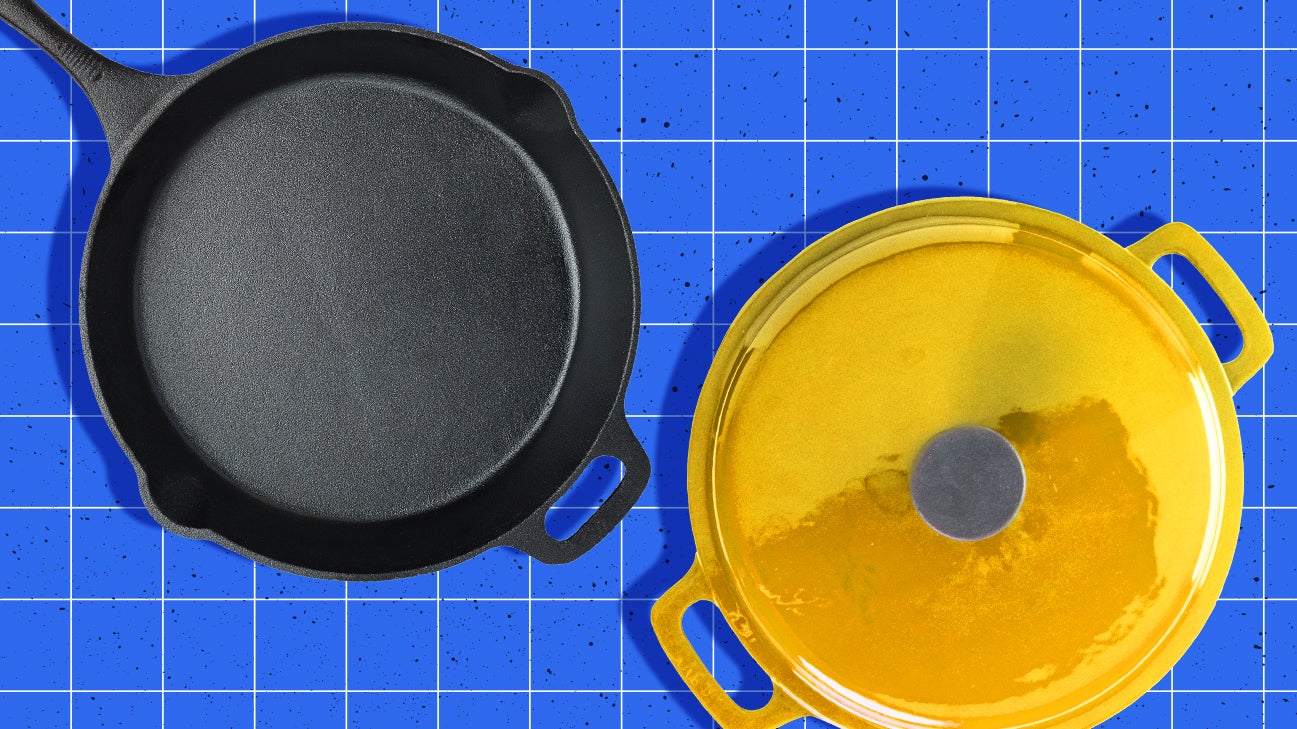Caring for cast iron means cleaning it, but it’s not as simple as popping your pan in the dishwasher. So how do you safely clean cast iron skillets, Dutch ovens, or fryers?

People rave about the benefits of their cast iron skillets: Oh, the heat retention! The stovetop and oven flexibility! The dietary iron! The nonstick surface (after seasoning)! But then there’s the cleaning, a task which stirs up conflict faster than a closed-door meeting on Capitol Hill. Cleaning your cast iron doesn’t have to be so tricky, though. Here’s how to do it right.
How to Clean a Cast Iron Skillet:
1. Start with a seasoned cast iron pan. If your skillet hasn’t been seasoned yet, rub it with oil and heat it. Each successive time you cook with it, the oil, butter, or animal fat will form another non-stick layer that also prevents rusting. So get cooking as soon as possible.
2. Rinse your cast iron skillet with hot water. Then wipe out the dirty bits with a sponge or brush. Don’t use soap—unless your pan has years of layered, polymerized seasoning on it—and never steel wool, because that can strip off the precious seasoning, especially with newer pans. Don’t put it in the dishwasher either. (If you’re still tempted, here’s another reason to refrain, courtesy of Rachael Ray: Cast iron is “very porous. That flavor will stay in there and literally bake into the pan.” You do not want that.)
3. Use salt and oil to remove leftover gunk. If you need something more abrasive to remove stubborn bits of leftover food debris, place a spoonful of coarse sea salt or kosher salt—or cornmeal—into your dirty cast iron skillet. Pour an equal amount of cooking oil, such as canola, vegetable, or corn, over the salt or cornmeal.
4. Use a paper towel to rub the salt-oil paste in a circular motion. This should remove the unwanted bits, but you can use a metal spatula or pan scraper to scrape off any hard-to-remove debris that won’t come loose.
5. Wipe out the salt and oil. When you’re satisfied the pan is clean, wipe out the salt and excess oil with a clean paper towel.
6. Rinse again and dry thoroughly. If your pan is really bad and burnt, you can rinse it with water again and dry thoroughly. Very thoroughly. (If water stays on the pan too long, it will rust.) If you use a cloth instead of paper towels, have a couple cast-iron-dedicated cloths, because the pan can blacken them (so don’t use your heirloom dish cloths inherited from grandma). Another way to dry it is to place the skillet over a high flame for a few minutes. Let it cool before completing the final step!
7. Rub in a bit more oil. Once the pan is totally dry and cool enough to touch, rub in some more oil just to give it a nice sheen, then heat it again for a couple minutes to help the oil absorb—and prevent the pan from getting sticky or rancid-smelling.
8. Store with a paper towel placed in the pan to help prevent rusting. (That’s another tip from Rachael Ray.)
Need more reassurance? Harry Rosenblum, co-owner of Brooklyn Kitchen, shows us how he cleans his cast iron pans in our video:
Cast Iron Skillet Recipes
Now that you know how to clean it, try some of our cast iron skillet recipes! (And next, tackle your dirty sheet pans.)
Eggplant and Mushroom Polenta Bake
Because this recipe contains acidic tomatoes, if your cast iron pan isn’t well seasoned, use use a heavy-bottomed ovenproof skillet or enameled cast iron pan instead. All the savory, earthy filling is topped with creamy polenta, made even more awesome by Parmesan and tons of fontina cheese. Get our Eggplant and Mushroom Polenta Bake recipe.
Skillet Pizza
Making the dough takes awhile, but once you have that part done, the rest is easy. Cast iron pans are the best when you need put the pan on the range first and then in the oven. The toppings are up to you, but tomatoes, burrata cheese, basil leaves are suggested. Get our Skillet Pizza recipe.
Skillet Cornbread
This is a dryer version of some cornbread recipes, meant to be a vehicle to wipe up that chili or barbecue sauce. The other bonus to it is you don’t need to buy buttermilk to make this cornbread. If you want more moist version that requires buttermilk, try our Basic Skillet Cornbread recipe. For the regular-milk, drier variety, get our Skillet Cornbread recipe.
Easy Salmon with Lemon and Capers
This is another recipe for well-seasoned cast iron skillets only. The lemon’s acidity can strip the lightly seasoned newer frying pans. Otherwise, it’s a great idea for dinner using your lovely cast iron. Get our Easy Salmon with Lemon and Capers recipe.
Cheesy Skillet Potato Cake
If your cast iron is used long enough to be considered a nonstick frying pan, then use it to make this perfect hangover food. Reminiscent of those scattered, covered, smothered, and chunked hash browns the inebriated love to get at Waffle House at 2 a.m., this is a good idea to satisfy a craving. Get our Cheesy Skillet Potato Cake recipe.
Skillet Pear Cake
Mmm, cake—in a skillet. Utilize fall and winter fruit like pears and apples in season, or swap in stone fruit for summer, and make this cake that you invert. It’s got brown sugar, cinnamon, and ripe fruit that caramelizes and softens until succulent. Get our Skillet Pear Cake recipe.
Campfire Cherry Cobbler
This easy camping-friendly dessert tastes great made in any Dutch oven—but one made from naked cast iron (as opposed to enameled) is best if you’re actually cooking over an open fire. You can also make it in a skillet, on the stove or on the coals! Get our Campfire Cherry Cobbler recipe.


0 Commentaires